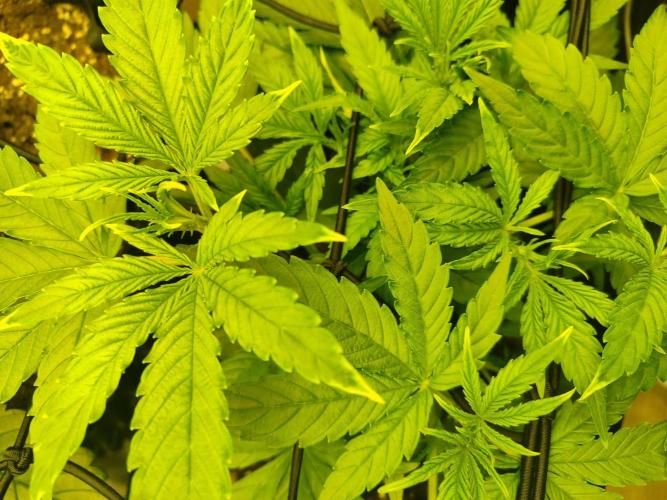The Grow Awards 2026 🏆 






















Potential causes and fixes for magnesium deficiency
DBQushstarted grow question 3y ago
My runoff EC and PH are normal and I am adding calmag to every feeding so not sure why I might have magnesium deficiencies.
Aside from giving them just a calmag feeding and foliars, any tips on what I can do and why this is even happening?
Solved
Leaves. Color - Yellow
Feeding. Deficiences
Techniques. Main-lining
likes
gottagrowsometimeanswered grow question 3y ago
Epsom salt will be your best bet.
Its the best source of mag/sulphur you can have for a plant. You can use as a foliar spray. Itl work much better than a calmag spray as with many calmags. There are a good few nutes in them.
So i like to use 1 fix for an issue. Not throw the whole kitchen sink at it. But that's me. I just find it much much better as a source of mag/sulphur. "If you do have an Epsom salt. Make sure its one NOT WITH ANY smellies in it like Aloe Vera or mentol"
Depending on your ambient ppm of your tap. You should be looking to add 140-200ppm to your tap. So, if your tap is 100 your ppm feed with Epsom salt either direct into sub or foliar spray, it will be 240ppm "if used as a spray, dim your lights for a few mins" you'll be surprised at how fast an Epsom salt feed soaks in. You should start seen an improvement with days.
Feel free to DM me more on this..
Good Growing
TheUk420Showanswered grow question 3y ago
I dont think your giving enough cal mag buddy that's what it looks like to me :) Rest of the plant looking healthy doing a great job keep up the great work :)
likes
Complain
Sciolistic_Steveanswered grow question 3y ago
it's not jsut about adding it, or even adding more of it... it's about adding the right amount that matches rate of growth, otherwise you run into deficiencies or toxicities.
if soilless this is easy as pie. Simply give 70-85ppm of Mg and adjust as needed as part of a well-balanced 1,3 to 1,5 EC feed, give or take. Some rare ones will want more or less.
in soil it's still adds up to the same mass added over time, except you have the unknown of what's in the soil. Also foliar sprays are great while you are having an issue, but if you properly feed a plant through its roots, there is no reason to do so on a regular basis. it's a great technique to quickly provide some nutrients locally -- not all of the molecules fit through the stomata. i don't foliar feed so i don't memorize such things. reference material is made to be referenced.
there are other considerations. A pH swing could make Mg less available even if you are giving enough molecules of Mg.
Antagonistic relationships with K goes both ways .. add either and you reduce availability of the other... after a certain point. existing concentrations and pH play a role in where that threshold is too.
... with Calcium, if you add too much of calcium it'll lockout Mg. this one doesn't go both ways.
Stimulative relationships:
Nitrogen -- add more and you need more Mg than before
Phosphorous -- goes both ways.. add more of either and you need to add more of the other (or if less added than before, less of the other than before too)
This stuff is fairly complicated and why you see so many seemingly similar environments with different needs and potential.
A 7:8:15 ratio of NPK (may need varying levels of N) with the other 3 secondary nutes totaling roughly 1,3 to 1,5 EC is essentially giving the plant all it needs on demand relative to good growth and ambient co2, and temps/rh that avoid extremes. you can probably get faster growth rates with more control, and you may need a higher concnetration of a well-balanced diet too.
likes
Complain
gottagrowsometimeanswered grow question 3y ago
Epsom salt will be your best bet.
Its the best source of mag/sulphur you can have for a plant. You can use as a foliar spray. Itl work much better than a calmag spray as with many calmags. There are a good few nutes in them.
So i like to use 1 fix for an issue. Not throw the whole kitchen sink at it. But that's me. I just find it much much better as a source of mag/sulphur. "If you do have an Epsom salt. Make sure its one NOT WITH ANY smellies in it like Aloe Vera or mentol"
Depending on your ambient ppm of your tap. You should be looking to add 140-200ppm to your tap. So, if your tap is 100 your ppm feed with Epsom salt either direct into sub or foliar spray, "if used as a spray, dim your lights for a few mins" you'll be surprised at how fast an Epsom salt feed soaks in. You should start seen an improvement with days.
Feel free to DM me more on this..
Good Growing
likes
Complain
Similar Grow Questions
Solved

Sorrowcz
Hello guys
I have problémy with leafs and purple stem on one plant of 7..
This plant is completly different of all others. She have minimum leafs and she start flowering 7 days before others..
Any ideas what i can do with that?
Leaves. Color - Yellow
Plant. Stem - Red or purple
3y ago
1
5
Solved

DFWmd
Mainline/Manifold: Trimming fan leaves after done with topping.Finishing up the topping portion of mainlining. P2 to be Nebula-Haze style and P3 to be Nugbuckets style. I'll be trimming growth tips other than from the 8 cola sites on each. Still keep un-shaded fan leaves below those levels? A lot online shows all lower fan leaves trimmed
2y ago
3
2
Solved

Oldmanbud__50
Ty I think will be light issue but iv added another 300w to help them on n see how they get on. I have been using a lower strength nutes because as a newb. I don't want to mess it up but think I will increase the nutes and all shud be good only seems to be the lower middle tyWeek 5
Leaves. Color - Yellow
5y ago
1
2
Solved

herbalistssword
More training now? or leave her longer?I've attached image from 7 days after defoliation and more LST and what she grew to today. Quite bushy, should I defoliate/tuck again so more light gets to lower branches? only do some more lst? more lst and defoliation? or leave her for now and let her grow? 35 days from seed
5y ago
1
2
Solved

CelticSmokey88
Yellow brownish leavesAny ideas what this is and what i should do to fix it its gorilla zkitlles currently on day10flower
Last feed
3ml biobizz vera
3ml biobizz heaven
1ml biobizz bloom
1ml biobizz top max
1.5ml biobizz grow
0.5 biobizz fish mix
2 days ago
Leaves. Color - Yellow
5y ago
2
3
Solved

Sq00
Have you ever seen that?I'm thinking either over-fertilization or Senesens, what do you think? Thanks guysIf you need more photos, let me know. I used to fertilize every time, but for the last few days I've been watering with plain water. Terra Vega 5ml/L Calmag 1m
Leaves. Color - Yellow
2mo ago
1
2
Solved

psuperman
Deficiency or Overthinking?Wondering if this is some sort of deficiency or maybe I’m overthinking? I know I overwater sometimes and I’m trying to get that under control however my other plant doesn’t look like this it’s more solid green. Temp is at 75 daily and humidity is 35-40%.
Week 4
Leaves. Color - Yellow
4y ago
3
2
Solved

Batidak
Yellow tips on top leaves onlyFirst i thought it was lightburn, but i raised my lights 2 times in the last week and no change. Does anyone know what my plant is trying to tell me? I use a growmix and just started to feed her for flower so maybe a shortage of some nutrient or still to much N in the soil?
Leaves. Color - Yellow
2mo ago
2
2
Solved

BullWeedDog
que puede ser esto en las puntas de mis hojasen las puntas de mis hojas de los brotes nuevo he notado algunas de un color mas claro o incluso en algunas las puntas quemadas que puedo ser esto???
Leaves. Color - Yellow
Other. General questions
Plant. Wilting
4y ago
1
1
Solved

stashio
Yellow edges to leavesHello fellow growers. I have noticed some yellow edges to a handful of
her leaves. pH droped a bit today down to 5.6 but has been stable at about 6.4 previously. Photos from the last few days show this problem has been creeping for a couple of days. Any ideas?
Week 10
Leaves. Color - Yellow
4y ago
1
6
Solved

AtlasGrowing
The entire plant has turned kind of yellow, but the most affected part are the old leaves.Week 5
Leaves. Color - Yellow
7y ago
3
5
Solved

Hydronaut
250 PPM? - Week 6 - Autoflower - GH TrioFresh res. New growth (cola pic) leaves are scorched a bit. Result of tox from 2+ weeks ago, still hot? My PH/PPM equilibrium is 250pmm w/ 0ppm H20. If I follow this rule (I never done), she would max out in 350ish PPM. Anyone follow the dance thru harvest? GH Trio nutes.Week 6
Feeding. Deficiences
4y ago
3
4
Solved

2x2growing
Mainlining worth it!I used to think mainlining wasn’t worth it because of the longer veg time but, that seems to be the only downside. Theres way more advantages with this technique I’ve found, especially after my latest grow.
What do you guys think about mainlining?
Techniques. Main-lining
5y ago
3
2


















